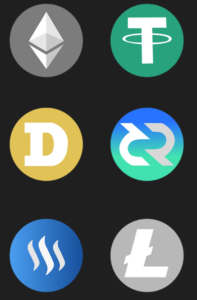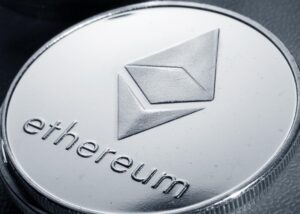
An altcoin is any cryptocurrency that is not Bitcoin.
Like Bitcoin, altcoins are based upon decentralized networks of computers, which validate network transactions, and keep a record of these transactions. And like Bitcoins, these computer networks are also used to make crypto. The network computers which do this work, and the people who own or manage such computers, are called miners, if they operate with a system called “Proof of Work”. Proof of Work is a crypto production system in which computers are rewarded crypto, not only for providing network operations, but also for solving types of complex complex mathematical problems. The reason for this requirement of solving math problems is that this added difficulty makes it more difficult malicious actors to manipulate the system and falsify transactions. Examples of proof of work altcoins include Litecoin, Bitcoin Cash, Monero and Bitcoin Gold. There is also Useful Proof of Work, utilized by the Qubic network, which substitutes BTC’s mathematical problems with AI-related problems, for more efficient use of computer resources, thus providing both crypto and AI products simultaneously.
One of the main alternatives to Proof of Work is Proof of Stake, in which network participants that perform network tasks put an amount of cryptocurrency into a particular account for a period of time, where it is kept as a form of insurance. They run one or more network computers, validating transactions and storing network data. These participants have financial incentive to properly perform the required network tasks, because, if they behave in a negligent or malicious manner, they risk losing some amount of the crypto that they provided as insurance. On the other hand, if they perform network tasks properly, they receive additional crypto as a reward for their services. While Proof of Work participants are generally called “miners”, Proof of Stake participants are usually called “validators”. The process of providing crypto as insurance in such a network is called “staking”, and those providing the crypto funds for this are called “stakers”. Miners and validators are rewarded with crypto, to incentivize them to participate in the network and perform the required network tasks. One of the benefits of staking is that even people who only possess a small amount of digital assets can join other investors, combining their resources to form staking pools. By contributing to these pools, investors can gain passive income, in the form of their share of the staking rewards (from Proof of Stake network activities). Such open economic structures allow individuals with almost all levels of income to participate in investing, and building our digital future.
There are a variety of methods for creating new crypto, for example Proof of Space, in which those who share their data storage facilities are rewarded with blockchain assets, as well as similar arrangements for those sharing their CPU, GPU, or wireless network facilities. For example, the Helium network provides crypto rewards to individuals who provide wireless network services, using small, very affordable devices.
Most of the altcoins, like Bitcoin, use blockchain software technology, however some altcoins do not employ blockchain, utilizing instead other types of decentralized software systems. Prominent examples of such non-blockchain crypto include Fantom and Holo.
One category of altcoins is transactional coins, similar to bitcoin, as they are made for the purpose of executing operations on units of value, like money. They can be regarded as a form of digital money, or gold. Prominent examples of such coins include Litecoin, Bitcoin Cash, and Bitcoin Gold. Like BTC, they use a Proof of Work algorithm, and also like BTC, these cryptocurrencies are mainly transactional, functioning as automated accounting systems, in which units of account are held or transferred. Though these networks are similar in focusing on transactions, there are important differences in the functionality of their software. For example, Litecoin has lower transaction fees than Bitcoin. Monero provides privacy. Bitcoin Gold, which can be produced with relatively inexpensive home computer equipment, as opposed to the costly equipment used in most current BTC production, allows greater participation in crypto production by the general public.
In contrast to transaction-based cryptocurrencies like BTC, and Litecoin, which are primarily used for financial transactions, there is an important category of altcoins, capable of far more than financial activities, because they can be programmed to do a wide variety of software tasks. While they can be used for financial transactions, they can also be programmed for a wide range of applications. For example, Web 3, the new decentralized internet, with all the benefits that it can bring to millions of users, is being built with this crypto tech.
Such altcoins can be called “smart contract crypto”. A “smart contract” is a type of software program that runs on the blockchain and can do a wide variety of activities, far beyond mere financial transactions. Such crypto is highly programmable software, that can be used to build the next generation of internet technologies, such as new websites, online games, and social media platforms.
One example of a smart contract, is a blockchain program that causes ownership of a digital asset to be given or sent to another person’s wallet, if a particular condition is met. For example, a smart contract can include code that sends a digital asset to a worker when he or she has completed a particular task. This could function as a guarantee to both the employee and the employer, proving payment as the automatic result of a the completion of a particular task, as specified in the smart contract. Similar arrangements can be made for insurance services, for example a smart contract that distributes crypto funds to farmers if there is too little rain during a period specified in the smart contract.
The largest crypto network of this kind is called Ethereum, the first smart contract crypto, which, at the time of writing, is the world’s second largest cryptocurrency network, in terms of capital investment, right after Bitcoin. There are a wide range of smart contract altcoins, including Solana, Avalanche, Cosmos, and Polkadot.
![]()
![]()
 In the real word, in contrast to the digital world, a “token” means “an object that looks like a coin, and is used instead of a coin, or in a manner similar to the way that a coin is used”. For example, tokens as solid, physical objects may be used in various games, machines, etc.
In the real word, in contrast to the digital world, a “token” means “an object that looks like a coin, and is used instead of a coin, or in a manner similar to the way that a coin is used”. For example, tokens as solid, physical objects may be used in various games, machines, etc.
A token is an item, similar to a coin, which is intended to have value or a particular use.
In crypto, a “token” is “a type of digital asset, added to a blockchain network that already had another, earlier, crypto asset, before the token was added to the network. The earlier crypto asset was the network’s original unit of transactions, made when the network and its software were first developed. The original crypto asset is built-in as a basic part of the software, and is used to pay network fees. A token is added to a network as an additional, second layer of crypto software, that can have various uses, including being a cryptocurrency for financial transactions.
The most basic, original transactional unit of a crypto network is usually called a “coin”, while the other types of crypto, which are added to the network later, are often called “tokens”. The Ethereum network has thousands of different types of crypto on it, but the basic type of crypto, the coin, is Ether, and the other types of assets are all tokens. As mentioned earlier, the main asset of the network, the coin, is generally used to pay network fees. It is possible to develop technology that allows tokens to also be used for the payment of such fees, however this is not generally the situation at the time of writing.
The basic network software, along with its coin, its basic (built-in) cryptocurrency, is similar to the operating system of a computer, for example Windows. A Windows computer comes with the Windows operating system as its basic layer of software technology, to which one can then add additional software applications, to do specific tasks, for example a browser or computer game. Such additional software, not part of the operating system, is a second layer of software technology which functions together with the more basic software of the operating system. The main software of a crypto network, together with its original cryptocurrency, are a type of operating system for the network. Other types of crypto, added to the network after the original crypto, are similar to the applications added to a computer, after installing the operating system.
Another example of different layers of software technology can be seen with the internet, in which there is a basic software system used for the general internet, and, added to this, there are additional types of software technology, consisting of particular websites and apps (for example Facebook and Google). These additional websites, etc. are added to, or built on top of, the more basic layer of technology, the general network which we call the internet. A general crypto network (together with its coin) is in some ways like a the general internet , and the tokens, added later, are like the websites and apps built upon the general system.
Subsequent to the development of of Ether, thousands of other types of crypto have been added to the Ethereum network as tokens.
A token is deployed to the network by programming a smart contract which creates the token as a new digital asset.
Disclaimer: This information here, and elsewhere on the website, is provided for entertainment, educational use, and the sharing of opinions and individual observations. This is not provided as advice from a financial advisor. The writer, SurfWeb3.com and/or its partners may own &/or have a financial interest in any or all of the items discussed on this website, &/or on connected social media platforms. There is no endorsement, nor any guarantee of quality, of items referred to on this website, including links, advertisements and affiliate relationships. The user of this site does so entirely and solely at his or her own risk. Please take personal responsibility for your investments, and do your own research.